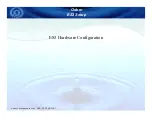
John Deere Air Reel Owner’s Manual
4
Congratulations on your choice of a new Crary Air Reel to complement your farming operation. This equipment has
been designed and manufactured to meet the needs of a discerning agricultural industry for the efficient harvesting of
crops.
Safe, efficient, and trouble free operation of your Air Reel requires that you and anyone else who will be operating or
maintaining the machine, read and understand the Safety, Operation, Maintenance and Troubleshooting information
contained within the owner’s manual. Check each item referred to and acquaint yourself with the adjustments required
to obtain efficient operation.
This manual covers all models of the Air Reel manufactured by Crary Industries for John Deere 200, 600, 900 and 900F
series headers. Differences are explained where appropriate. Use the Table of Contents as a guide to locate required
information.
Keep this manual handy for frequent reference and to pass on to new operators or owners. Call your Crary dealer or
distributor if you need assistance, information, or additional copies of the manual.
Many people have worked on the design, production, and delivery of this machine. They have built into it the highest
quality of materials and workmanship. The information in this manual is based on the knowledge, study, and experience
of these people through years of manufacturing specialized farming machinery.
The performance of the machine depends on proper maintenance and adjustment. Even if you are an experienced operator
of this or similar equipment, we ask you to read the owner’s manual before operating the machine. Keep the manual handy
for future reference. It has been carefully prepared, organized, and illustrated to assist you in finding the information you
need. Your Crary dealer will be happy to answer any further questions you may have about the machine.
OPERATOR ORiENTATiON -
All references to left, right, front and rear of the machine, as mentioned throughout the
manual, are determined by standing behind the machine and facing the direction of forward travel.
Section
iNTRODUcTiON
1







































